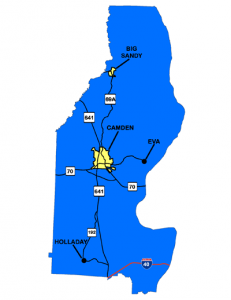History of Benton County Emergency Communications District
 The Benton County Emergency Communications District was created on August 4, 1988 by a referendum of voters in Benton County, Tennessee, to be an emergency communications district as defined by Tennessee state law. As such, it is considered to be a “municipality” or public corporation in perpetuity under its corporate name and shall be a body politic and corporate with power of perpetual succession, but without power to levy or collect taxes. Bernard Arnold was put in place as the original director of the ECD and served in that role from 1989 until 2008 and was the only employee of the district. The first call center for Benton County was located at 119 Main Street which is the present day police department for the City of Camden. All calls that came into the call center we transferred to the appropriate response agency for dispatch purposes. The first independent audit of the district’s budget was done on the years spanning 1989-1992 with a total amount of expenses of $80,000.
The Benton County Emergency Communications District was created on August 4, 1988 by a referendum of voters in Benton County, Tennessee, to be an emergency communications district as defined by Tennessee state law. As such, it is considered to be a “municipality” or public corporation in perpetuity under its corporate name and shall be a body politic and corporate with power of perpetual succession, but without power to levy or collect taxes. Bernard Arnold was put in place as the original director of the ECD and served in that role from 1989 until 2008 and was the only employee of the district. The first call center for Benton County was located at 119 Main Street which is the present day police department for the City of Camden. All calls that came into the call center we transferred to the appropriate response agency for dispatch purposes. The first independent audit of the district’s budget was done on the years spanning 1989-1992 with a total amount of expenses of $80,000.
Today, the district still only employs a director as the only employee of the district. The call center is now located at 116 Rosemary Ave in Camden, the current location of the Benton County Sherriff’s Department where all 9-1-1 calls are answered and either dispatched by the telecommunicator who answers it or transferred to the necessary response agency that needs to be dispatched.
History of 9-1-1
The three-digit telephone number “9-1-1” has been designated as the “Universal Emergency Number” for citizens throughout the United States to request emergency assistance. It is intended as a nationwide telephone number and gives the public fast and easy access to a Public Safety Answering Point (PSAP).
9-1-1 Timeline
- 1957 – In the US, the National Association of Fire Chiefs recommended use of a single number for reporting fires.
- 1967 – The President’s Commission on Law Enforcement and Administration of Justice recommended that a “single number should be established” nationwide for reporting emergency situations.
- November 1967 – The FCC met with the American Telephone and Telegraph Company (AT&T) to find a means of establishing a universal emergency number that could be implemented quickly.
- 1968 – AT&T announced that it would establish the digits 9-1-1 (nine-one-one) as the emergency code throughout the United States. The code 9-1-1 was chosen because it best fit the needs of all parties involved.
- February 16, 1968 – Senator Rankin Fite completed the first 9-1-1 call made in the US in Haleyville, Alabama.
- February 22, 1968 – Nome, Alaska implemented 9-1-1 service.
- Early 1970s – AT&T began the development of sophisticated features for the 9-1-1 with a pilot program in Alameda County, California called “selective call routing.”
- End of 1976 – 9-1-1 was serving about 17 percent of the population of the United States.
- 1979 – Approximately 26 percent of the population of the United States had 9-1-1 service, and nine states had enacted 9-1-1 legislation. At this time, 9-1-1 service was growing at the rate of 70 new systems per year.
- 1987 – Those figures had grown to indicate that 50 percent of the U.S. population had access to 9-1-1 emergency service numbers.
- End of the 20th century – nearly 93 percent of the population of the United States was covered by some type of 9-1-1 service. Ninety-five percent of that coverage was E9-1-1.
- Today – Approximately 96 percent of the U.S. is covered by some type of 9-1-1.
